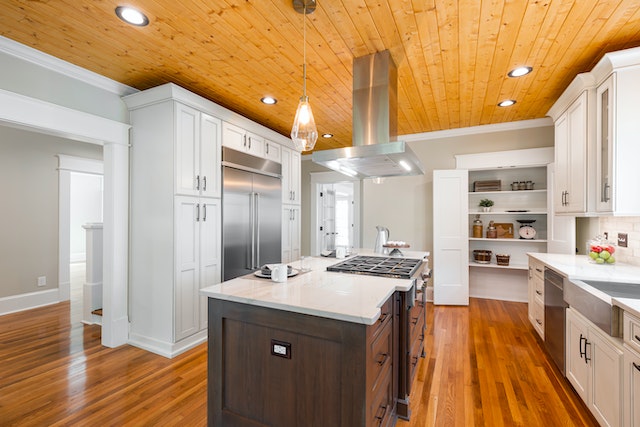A kitchen with a cooking island is the dream of many ambitious hobby chefs. The free-standing block has been in vogue in the USA for many years and stands for open-plan living kitchens for well-being and freedom of movement.
How much space do you need for the kitchen islands, which variants are available, and how much does it cost? This article will explain how to choose the correct kitchen set.
Cooking Islands for Small Kitchens
There are also kitchen islands, which are designed specifically for small kitchens. However, this is more than just a cooking island. Instead, it is a kitchen block, which you can place in the center of the room and use as additional storage space.
If you do not want to do without a small cooking island, choose a so-called “peninsula” instead of a free-standing kitchen island. This refers to an island that stands to one side against the wall or a built-in kitchen unit. This can be installed in kitchens from 10 square meters and is therefore also suitable as a kitchen island for small kitchens.
Kitchen Island Ideas: 3 Variants
A kitchen with a cooking island needs more space than other system kitchens. After all, the free-standing work surface must be easily accessible from all sides. Therefore, experts advise that the kitchen should be at least 15 square meters. In addition, the shape of the room should be square. Tube-like rooms are not suitable for island kitchens. On the other hand, particularly spacious rooms that combine living and dining areas are perfect.
Installation options for kitchen islands:
- Kitchen island for cooking or sinks. If you like to cook and enjoy the freedom of movement, you can install a glass ceramic or induction hob on the kitchen island. Or you can place the sink on the kitchen island. With both options, the difficulty is that appropriate wiring and connections must be in place. You need heavy current for the stove and oven, and power must also be provided for the stove hood. For the sink, you need to have water connections to ensure inflow and outflow.
- Kitchen with island for storage. For this type, no connections are needed because the island kitchen is used only for the storage of utensils or as an additional work surface. Therefore, this variant is also perfect for retrofitting. You can determine the size and design yourself. In addition, this is a comparatively inexpensive variant of a kitchen island.
- The kitchen island is a place to sit. For more coziness, your kitchen provides a kitchen island equipped with bar stools, inviting you to linger. Here, guests or family members can sit with you in the kitchen and chat or help you prepare the meal.
Depending on the size and features of your island kitchen, the price can be quite different. In general, kitchen islands are more expensive than conventional kitchen units. This is because two worktops are needed, and more planning is often involved in the assembly. There are no upper limits, especially if you choose a luxury model with high-quality materials from a well-known manufacturer and higher-priced electrical appliances.

